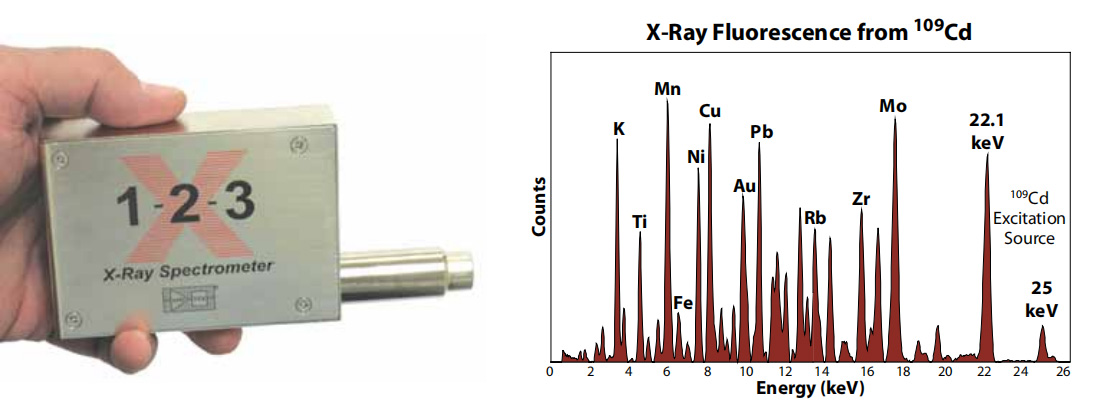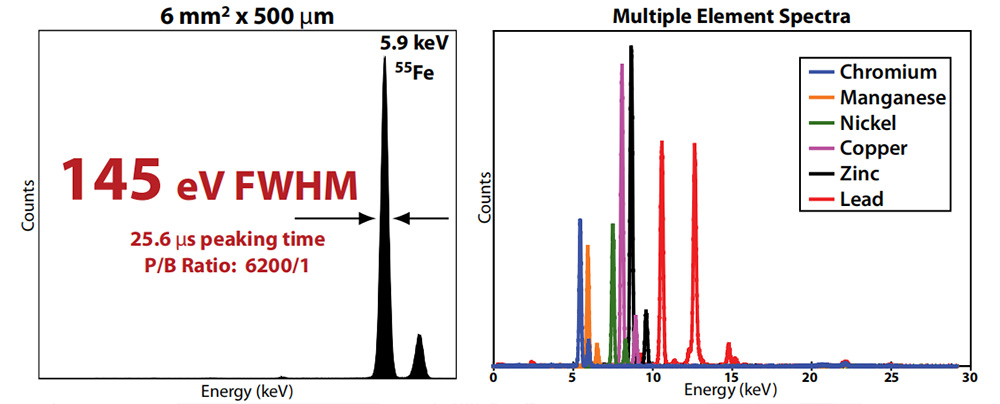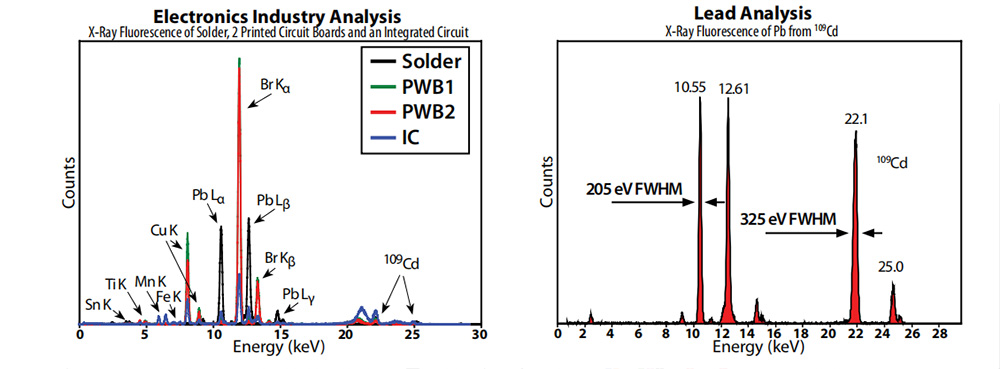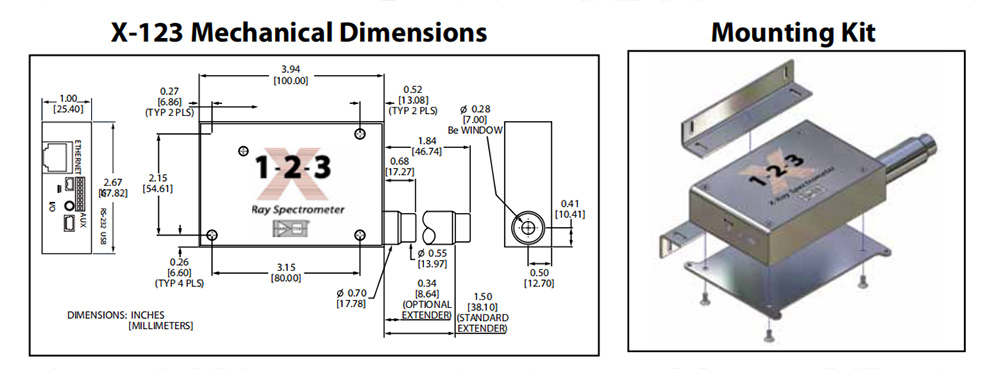

Our philosophy has always been to create small, low power, high performance instruments while keeping them simpleto operate.The X-123 exemplifies this philosophy by providing in a single package the XR-100 Detector and its Charge Sensitive Preamplifier; the DP5 Digital Pulse Processor with pulse shaper,MCA, and interface; and the PC5 Power Supply. All that is needed is a 5 Volts DC input and a USB or RS232 connection to your computer.
The X-123 is a complete X-Ray Detector System in one small box that fits in your hand.
3 Power Supply and Interface with PC
| Features | Detector |
| ? Compact integrated system | ? Si-PIN for X-ray detection |
| ? Simple to operate | ? 2-Stage thermoelectrical cooler |
| ? Small size (2.7 x 3.9 x 1 in or 7 x 10 x 2.5 cm) | ? Area: 6 to 25 mm2 |
| ? Low power (2.5 W) | ? Thickness: 300 to 500 μm |
| ? Light weight (6.3 oz or 180 g) | ? Accommodates all types of Amptek detectors |
| ? USB and RS232 Communication |
| Applications | Typical Performance |
| ? X-Ray Fluorescence Instrumentation | ? Resolution: 145 to 260 eV FWHM at 5.9 keV |
| ? RoHS / WEEE Compliance | ? Optimum energy range: 1 keV to 40 keV |
| ? Process Control | ? Max count rate: Up to 2 x 105 cps |
| ? Art and Archaeology | |

| System Performance | |
| Energy Resolution | 145 to 260 eV FWHM @ 5.9 keV. Depends on detector,peaking time, and temperature. |
| Energy Range | Efficiency is >25% for X-rays from 1.5 to 25 keV. May be used outside this range with lower efficiency. |
| Maximum Count Rate Depends on peaking time. Recommended maxima for 50% dead time with pile-up rejection enabled are shown below: DP5 Peaking Time (μs) 2.4 μs 6.4 μs 25.6 μs Shaping Time (μs) 1.0 μs 2.9 μs 11.6 μs Recommended Max Rate (s-1) 1.2 x 105 4.6 x 104 1.2 x 104 | |
| Detector and Preamplifier | |
| Detector Type | Si-PIN, SDD or CdTe |
| Detector Size | 6 mm2 to 25 mm2 |
| Silicon Thickness | 300 μm and 500 μm |
| Be Window Thickness | 1 mil (25 μm) or 0.5 mil (12.5 μm) |
| Collimator | Multilayer |
| Thermoelectric Cooler | 2-stage |
| Preamplifier Type | Amptek custom design with reset through HV connection. |
| Pulse Processor | |
| Gain | Combination of coarse and fine gain yields overall gain continuously adjustable from 0.84 to 127.5 |
| Coarse Gain | Software selectable settings from 1.12 to 102 in 16 log steps. 1.12, 2.49, 3.78, 5.26, 6.56, 8.39, 10.10, 11.31,14.56, 17.77, 22.42, 30.83, 38.18, 47.47, 66.26, 102.0 |
| Fine Gain | Software selectable, 0.75 to 1.25, 10 bit resolution |
| Full Scale | 1000 mV input pulse @ x1 gain |
| Gain Stability | <20 ppm / °C (typical) |
| Pulse Shape | Trapezoidal |
| Peaking Time | 24 software selectable peaking times between 0.8 and 102 μs, approximately log spaced, corresponding to semi-gaussian shaping times of 0.4 to 45 μs. |
| Dead Time | Total dead time is 1.05 times the peaking time. No conversion time. |
| Fast Channel Pulse Pair Resolving Time | 120 ns |
| MCA | |
| Number of Channels | Commandable to 8k, 4k, 2k, 1k, 0.5k, or 0.25k channels |
| Presets | Time, total counts, counts in an ROI, counts in a channel |
| Communications | |
| USB | 2.0 full-speed (12 Mbps) |
| Serial | Standard RS232 at 115.2 k or 57.6 Kbaud |
| Ethernet | 10 base-T |
| Power | |
| Nominal Input | +5 VDC at 500 mA (2.5 W) (typical). Current depends stronly on detector ?T. Ranges from 300 to 800 mA at 5 VDC. AC adapter provided. |
| Input Range | 4 V to 6 V (300 to 200 mA, 500 mA max)) |
| High Voltage Supply | Internal multiplier, adjustable to 400 V |
| Cooler Supply | Closed loop controller with ?Tmax = 85°C |
| General and Environmental | |
| Operating Temperature | -20 °C to +50 °C |
| Warranty Period | 1 year |
| Typical Device Lifetime | 5 to 10 years, depending on use |
| Storage and Shipping | Typical: -20 °C to +50 °C, 10 to 90% humidity noncondensing Long-term storage: 10+ years in dry environment |
| Compliance | RoHS Compliant |
| Connectors | |
| USB | Standard USB Mini jack |
| RS232: Standard 2.5 mm stereo audio jack Tip Transmit To PC Receive DB9 pin 2 (DB25 pin 3) Ring Receive To PC Transmit DB9 pin 3 (DB25 pin 2) Sleeve Ground To PC Ground DB9 pin 5 (DB25 pin 7) | |
| Ethernet | Standard Ethernet connector (RJ-45) |
| Power | Hirose MQ172-3PA(55), Mating plug: MQ172-3SA-CV |
| Auxiliary 2 x 8 16-pin 2 mm spacing (Samtec part number ASP-135096-01). Mates with cable assembly (Samtec P/N TCMD-08-S-XX.XX-01). Top row odd pins, bottom row even pins. Top right pin = 1, bottom right pin = 2. Pin # Name Pin # Name 1 SCA1 2 SCA2 3 SCA3 4 SCA4 5 SCA5 6 SCA6 7 SCA7 8 SCA8 9 AUX_IN_1 10 AUX_OUT_1 11 AUX_IN_2 12 AUX_OUT_2 13 IO2 14 IO3 15 GND 16 GND | |
| Interface Software | |
| ADMCA: The X-123 can be controlled by the Amptek ADMCA display and acquisition software. This software completely controls and configures the X-123, and downloads and displays the data. It and supports regions of interest (ROI), calibrations, peak searching, and so on. The ADMCA software includes a seamless interface to the XRF-FP quantitative X-ray analysis software package. Runs under Windows 98SE or later (32-bit only) on PC compatible computers. Windows XP PRO SP2 or later recommended. | |
| DPP API: The X-123 comes with an Application Programming Interface (API) in the form of a DLL library. The user can use this library to easily write custom code to control the X-123 for custom applications or to interface it to a larger system. Examples are provided in VB, VC++, etc. on how to use the API. A Window CE/Pocket PC version is also provided. | |
| VB Demonstration: The VB demonstration software runs on a personal computer and permits the user to set the X-123 parameters, to start and stop data acquisition, and to save data files. It is provided with source code and can be modified by the user. This software is intended as an example of how to manually control the X-123 through either the USB or RS-232 interface using the most basic calls without the DPP API. This is primarily needed as an example when writing software for non-Windows platforms. | |
The use of digital technology improves several key parameters:(1) better performance, specifically better resolution and operation at higher count rates;(2) greater flexibility since more configuration options are available and they are selected by software over a RS-232 interface, and (3) improved stability and reproducibility.The DP5 digitizes the preamplifier output, applies real-time digital processing to the signal, detects the peak amplitude (digitally), and binsthis value in its histogramming memory, generating an energy spectrum. The spectrum is then transmitted over the DP5’s interface to the user’s computer. The Amptek DP5 has 6 main function blocks to implement these functions: (1) an analog prefilter; (2) an ADC; (3) a digital pulse shaper; (4) pulse selection logic; (5) histogram logic, and (6) interfacing hardware (which includes a microcontroller) and software.
The power supply is Amptek’s PC5, a single board.The input is approximately +5 VDC with a current of about 200mA.The PC5 uses switching supplies to produce all the low voltages required for the digital processor and the preamplifier. It also includes a high voltage multiplier to produce the detector bias voltage, up to 400 V, and supply for the thermoelectric cooler which provides closed loop control with a maximum temperature differential of 85?C.




 微信二維碼
微信二維碼